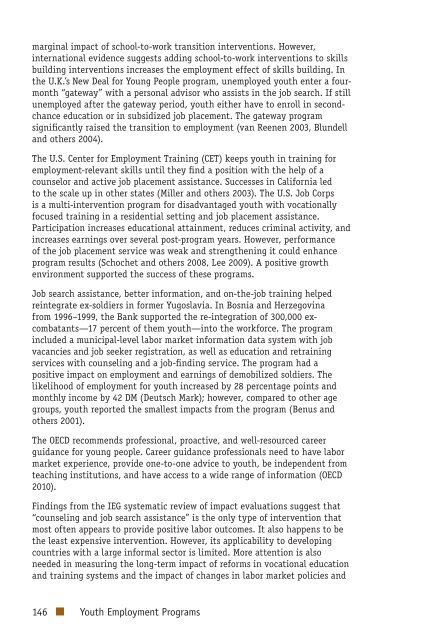Youth Employment Programs - Independent Evaluation Group
Youth Employment Programs - Independent Evaluation Group
Youth Employment Programs - Independent Evaluation Group
You also want an ePaper? Increase the reach of your titles
YUMPU automatically turns print PDFs into web optimized ePapers that Google loves.
marginal impact of school-to-work transition interventions. However,international evidence suggests adding school-to-work interventions to skillsbuilding interventions increases the employment effect of skills building. Inthe U.K.’s New Deal for Young People program, unemployed youth enter a fourmonth“gateway” with a personal advisor who assists in the job search. If stillunemployed after the gateway period, youth either have to enroll in secondchanceeducation or in subsidized job placement. The gateway programsignificantly raised the transition to employment (van Reenen 2003, Blundelland others 2004).The U.S. Center for <strong>Employment</strong> Training (CET) keeps youth in training foremployment-relevant skills until they find a position with the help of acounselor and active job placement assistance. Successes in California ledto the scale up in other states (Miller and others 2003). The U.S. Job Corpsis a multi-intervention program for disadvantaged youth with vocationallyfocused training in a residential setting and job placement assistance.Participation increases educational attainment, reduces criminal activity, andincreases earnings over several post-program years. However, performanceof the job placement service was weak and strengthening it could enhanceprogram results (Schochet and others 2008, Lee 2009). A positive growthenvironment supported the success of these programs.Job search assistance, better information, and on-the-job training helpedreintegrate ex-soldiers in former Yugoslavia. In Bosnia and Herzegovinafrom 1996–1999, the Bank supported the re-integration of 300,000 excombatants—17percent of them youth—into the workforce. The programincluded a municipal-level labor market information data system with jobvacancies and job seeker registration, as well as education and retrainingservices with counseling and a job-finding service. The program had apositive impact on employment and earnings of demobilized soldiers. Thelikelihood of employment for youth increased by 28 percentage points andmonthly income by 42 DM (Deutsch Mark); however, compared to other agegroups, youth reported the smallest impacts from the program (Benus andothers 2001).The OECD recommends professional, proactive, and well-resourced careerguidance for young people. Career guidance professionals need to have labormarket experience, provide one-to-one advice to youth, be independent fromteaching institutions, and have access to a wide range of information (OECD2010).Findings from the IEG systematic review of impact evaluations suggest that“counseling and job search assistance” is the only type of intervention thatmost often appears to provide positive labor outcomes. It also happens to bethe least expensive intervention. However, its applicability to developingcountries with a large informal sector is limited. More attention is alsoneeded in measuring the long-term impact of reforms in vocational educationand training systems and the impact of changes in labor market policies and146 <strong>Youth</strong> <strong>Employment</strong> <strong>Programs</strong>
















